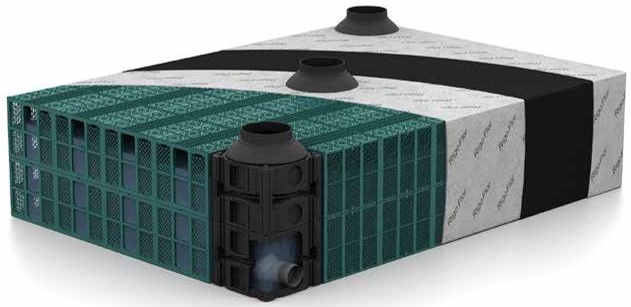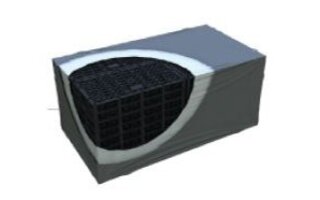You have no items in your shopping cart
Infiltration crates
Infiltration crates
Infiltration systems are designed to collect rainwater and infiltrate it into the soil. They consist of infiltration crates, also known as infiltration boxes or infiltration wells. These crates are made of plastic and have an open structure, making it easy to collect and infiltrate rainwater. The infiltration system is equipped with geotextile to prevent the crates from becoming clogged with dirt and sediment. This geotextile ensures that only water can reach the crates, while dirt and sediment are kept out. The rainwater is led via a drainage system to the infiltration crates, where it gradually seeps into the soil. This means that rainwater is not drained directly into the sewer, but can be processed naturally. Infiltration systems can be used in both new construction projects and existing buildings. They contribute to sustainable water management and reduce the burden on the sewer system during heavy rainfall. By infiltrating rainwater, the groundwater level is also maintained and the risk of flooding in the area is reduced.
Why infiltrate. By the end of this article you will know
Infiltration is important for several reasons. Firstly, infiltration crates offer many advantages. They can be used for various applications such as regulating water management, recharging groundwater, preventing floods and protecting the environment. In addition, infiltration crates contribute to sustainable water use and promote biodiversity. The use of infiltration crates also has positive environmental effects, as they help reduce the impact of rainwater runoff on the environment. In short, infiltration crates are an essential tool in managing and protecting water resources and promoting sustainability in our ecosystem.
Faster infiltration and better drainage of rainwater
Faster infiltration and better drainage of rainwater is crucial to tackle various problems. Firstly, it contributes to the reduction of flooding, which is a common problem during heavy rainfall. By using infiltration systems, rainwater can be efficiently collected and infiltrated into the ground, which can prevent flooding.
In addition, the protection of the sewerage system plays an important role. During heavy rainfall, the sewerage system can become overloaded, resulting in rainwater not being drained away quickly enough. This can lead to blockages, flooding and damage to infrastructure. The use of infiltration systems ensures that part of the rainwater is infiltrated directly into the soil, reducing the pressure on the sewerage system.
In addition, faster infiltration and better drainage of rainwater contribute to the prevention of flooding. Floods can cause major damage to buildings, infrastructure and the environment. By using infiltration systems, rainwater can gradually infiltrate into the soil, reducing the risk of flooding.
Another advantage of infiltration systems is that they promote natural drainage. Rainwater that infiltrates into the soil can be absorbed by plants and trees, helping to maintain a healthy ecosystem. In addition, infiltration can help replenish groundwater reserves, which is important for water management.
Finally, faster infiltration and better drainage of rainwater leads to an improvement in water quality. Rainwater that lands on streets and other paved surfaces often carries contaminants such as oil, heavy metals and pesticides. By using infiltration systems, rainwater in the soil can be filtered, causing these contaminants to be broken down and absorbed by the soil. This contributes to cleaner and healthier water quality.
Maintenance and calculation of infiltration crates
To ensure that infiltration crates function optimally, it is important to carry out regular maintenance. An important aspect when maintaining infiltration crates is calculating the required capacity. Various factors are taken into account, such as the surface area of the site, rainfall intensity, soil permeability and the storage capacity of the infiltration crate.
First of all, it is important to determine the area of the site on which the infiltration system will be installed. This could be, for example, a parking lot, a garden or a business site. Based on this surface area, the required capacity of the infiltration crate can be calculated.
In addition, rainfall intensity plays a role in determining the required capacity. The higher the rainfall intensity in a certain area, the greater the capacity of the infiltration crate must be to collect the rainwater.
Soil permeability is also an important factor to take into account. This determines how quickly rainwater can infiltrate into the soil. If the soil is poorly permeable, a larger storage capacity will be required in the infiltration crate to store the water. They are often used in areas where the drainage of rainwater is problematic, for example due to a high groundwater level. The height of the groundwater is therefore also an important factor when sizing and determining the capacity of infiltration crates.
Finally, the storage capacity of the infiltration crate itself is important. This capacity indicates how much water the infiltration crate can collect before the water infiltrates to the bottom. It is important that the storage capacity is sufficient to collect rainwater, so that no flooding occurs.
To ensure that infiltration crates continue to function properly, it is important to carry out regular maintenance. This may include cleaning the infiltration crates to prevent blockages, checking the storage capacity and possibly replacing damaged parts. By carrying out regular maintenance, the lifespan of infiltration crates can be extended and they continue to function optimally.






